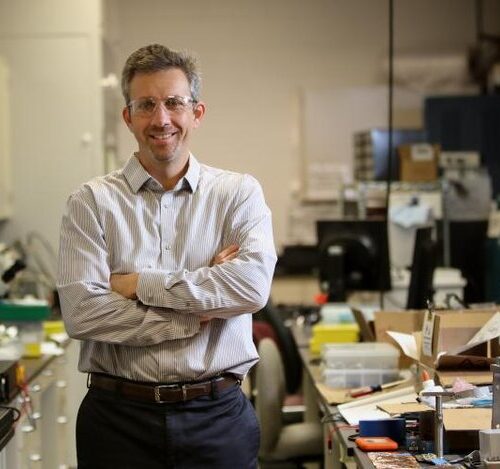
Dr. Yarom Polsky
Topic Area Leader
Dr. Eric Hoek
Deputy Topic Area LeadThe Challenge
The state-of-the-art paradigm for industrial and municipal scale desalination is a site-specific sequence of pretreatment, treatment, post-treatment, and residuals management processes. Nearly every project uses a customized design that draws from a large number of possible combinations of the currently available physical, chemical and biological processes. That paradigm was developed in an era of centralized desalination needs. Critical challenges related to process innovation include: a narrow operating range for current desalination technologies that results in system fragility and necessitates a range of expensive and energy-intensive pre- and post-treatment processes; a unit operations mindset that adds complexity and cost to systems; and labor intensive and sub-optimal operation of water treatment systems when variability of influent water conditions vary or subsystem issues are experienced.
Our Approach
This topic area advances two categories of research and development critical to advancing NAWI goals: (1) novel and intensified processes and (2) autonomous and adaptable water systems. The potential impacts of novel process concepts, component technologies and control methodologies for this topic area will be evaluated in the context of pipe parity metrics such as life-cycle energy demand, levelized cost of water and system reliability. Example target outcomes for this topic area include the following: (1) Novel technologies and processes that extend the operating range of treatment systems to reduce pre- and post-treatment steps, energy intensity, and cost of treatment trains; (2) Process-intensified methods that result in at least a 2× reduction in the cost of brine concentration and enable high recovery compared to current state of the art technologies; and (3) advances in water treatment system automation, process monitoring and process control that that enable closed-loop feedback control, optimized system performance, early detection and self-correction of system faults, adaptation to variable feedwater conditions, and reduced system operating, maintenance, and labor costs.
Projects
Project 5.02Platform Process for Electrified Pretreatment Lead: David Jassby, University of California at Los Angeles
This project team developed an experimental methodology that combines probing electrochemical reactions and surfaces at the atomic, nano, and micron scale using an array of characterization tools, and uses these observations/insights to better understand macro-scale (i.e., system-wide) electrochemical characterization methods.
Partners: Georgia Tech, Oak Ridge National Laboratory
Project 5.03Foundational Control Methods For Water Treatment Systems Lead: Kris Villez, Oak Ridge National Laboratory
This project focuses on developing approaches and methods for online model identification that enable autonomous monitoring, control, and optimization of decentralized, remote, and unstaffed water/wastewater treatment systems. The project is focused on demonstration of the fundamental capacity to perform process optimization with generic, empirical models.
Partners: Baylor, Colorado School of Mines, Rockwell
Project 5.04Computational Test Bed for Predictive Fouling Control Lead: Dan Miller, Lawrence Berkeley National Laboratory
This project is developing computational models simulating feed flows and inorganic scaling in spiral-wound RO elements. The models seek to understand the formation and growth of scale and unsteady flow effects in the membrane module feed channel.
Partners: Colorado School of Mines, University of Texas at Austin
Project 5.05CFD modeling and operando measurements of multiscale heat and mass transfer for membrane module customization Lead: Meagan Mauter, Stanford University
This project will use X-ray techniques to directly measure velocity and concentration gradients in complex membrane module flow channels. These measurements will be used to validate advanced CFD models of RO, Osmotically Assisted Reverse Osmosis (OARO), and Membrane Distillation. The validated CFD models will inform the design of tailored 3D printed spacers geometries that maximize mass and heat transport rates throughout the module for specific feed chemistries and operating conditions (including non-steady state operation).
Partners: SLAC National Accelerator Laboratory, Aqua membranes, Inc., Cascade Technologies, Inc
Project 5.06 Novel Electro-dialytic Crystallizer (EDC) for Energy Efficient Zero-liquid Discharge Lead: Shihong Lin, Vanderbilt
This project aims to develop a modular brine concentration/ crystallization process that is substantially more energy efficient than the current state-of-the-art thermal processes. The team aims to investigate a new brine crystallization process called electro-dialytic crystallization (EDC), which integrates electrodialysis and crystallization into a single system to enable crystallization without evaporation or large temperature swings, thereby potentially improving the energy efficiency and reducing the cost of crystallization.
Partners: Black & Veatch, Colorado State University
Project 5.07 Solvent-Driven Zero Liquid Discharge for Production of Synthetic Gypsum Lead: Aaron Wilson, Idaho National Laboratory
This project pioneers the use of dimethyl ether (DME)-Driven Zero Liquid Discharge (ZLD) desalination potentially reducing ZLD costs 50% relative to state-of-the-art crystallizers.
Partners: Massachusetts Institute of Technology, Trevi Systems, USG Corporation
Project 5.08 Advanced Process Controls – Autonomous Control and Optimization Lead: Kris Villez, Oak Ridge National Laboratory
This project will develop novel process control methods for water treatment facilities that enable operators to predict and adapt to impending process upsets and equipment failures to enable safe and reliable operations of desalination and water reuse facilities.
Partners: Baylor University, Colorado School of Mines, Colorado Springs Utilities, inCTRL Solutions, IntelliFlux Controls, Inc., Rockwell Automation
Project 5.09 Process Twins for Decision-Support and Dynamic Energy/Cost Prediction in Water Reuse Processes Lead: Diego Rosso, University of California at Irvine
This project will develop physical and digital twins of desalination and related treatment processes operating in several water plants to enable operators to better understand the consequences of large deviations from normal operation.
Partners: Oak Ridge National Laboratory, Orange County Water District, Hampton Roads Sanitation District, Glacier Technologies International, Inc., Brown and Caldwell, Los Angeles County Sanitation Districts
Project 5.10 Analytics for Causal Analysis and Decision Support Models for Autonomous and Smart Water Treatment Lead: Prakash Rao, Lawrence Berkeley National Laboratory
NAWI-RO-Automation-5.10-Poster-June2025
This project will push the frontier of artificial intelligence in water treatment operations by developing autonomous, adaptive, and co-learning water treatment and desalination systems enabled by fundamental process operation building blocks that predict the operational performance of such systems.
Partners: University of California at Los Angeles, California State University, San Bernardino
Project 5.11 Additive Manufacturing for Customized Membranes Lead: Jeff McCutcheon, University of Connecticut
This project advances a breakthrough method for manufacturing thin-film composite membranes using Nano-scale 3D printing that will enable membranes to be created for specific separations needs at low cost.
Partners: The University of Texas at Austin, Argonne National Laboratory, NALA Systems, Inc., ZwitterCo, Inc., Vortex Engineering LLC
Project 5.12 Electromagnetic Field for Membrane Scaling Control Lead: Pei Xu, New Mexico State University
This project will rigorously and systematically investigate electromagnetic fields (EMF) that have been shown to suppress the nucleation of “scale-forming” minerals in desalination systems.
Partners: Oak Ridge National Laboratory, New Mexico Produced Water Research Consortium, Flow-Tech Systems, LLC, EVUS, Inc., El Paso Water, Aqua Membranes Inc., NGL Energy Partners, LP
Project 5.13 Tailored Reductants for Selenium Removal in Iron Electrocoagulation Lead: Dan Giammar, Washington University in St. Louis
This project will target selenium, a problematic naturally-occurring element that is not easily removed by reverse osmosis (RO), and can contaminate wastewater in many industrial applications, with a novel electrochemical method of particle removal called electrocoagulation.
Partners: Lawrence Berkeley National Laboratory, Electric Power Research Institute, WaterTectonics, Inc.
Project 5.14 Enabling Minimal Liquid Discharge Through a Modular, Flexible, and Electrified Pretreatment System Lead: David Jassby, University of California at Los Angeles
This project will develop a combination electrochemical reactor based on electrocoagulation with an immersed filtration system to react and separate problematic contaminants in water in a single modular step prior to desalination.
Partners: Georgia Institute of Technology, Oak Ridge National Laboratory, Electric Power Research Institute, Knoxville Utilities Board, WaterTectonics, Inc., Southern Company
Project 5.15 Electrocoagulation/electrooxidation to accelerate cost-effective potable water reuse Lead: Shankar Chellam, Texas A&M University
This project will develop hybrid iron-iron and iron-carbon electrocoagulation/electro oxidation (EC/EO) systems for pretreating secondary wastewater effluent prior to microfiltration and desalination and improve log10 virus reduction and remove suspended particles in a single step.
Partners: Oak Ridge National Laboratory, WaterTectonics, Inc., KIT Professionals, Inc., Orange County Water District, CAP Water & Power International, Inc.
Project 5.16 Energy-efficient selective removal of metal ions from mining influenced waters (MIW) using H-bonded Organic-Inorganic Frameworks (HOIFs) Lead: Nick Gurieff, Rio Tinto Services Inc.
The H-Bonded Organic-Inorganic Frameworks technology will bring tremendous value into the treatment of nonconventional waters with reduced energy consumption, system complexity, and waste management costs while providing unmatched brine valorization and profit recovery. The precision separation and recovery of metals in acid mine drainage (AMD) waters may also expand the availability of critical materials and help alleviate dependency on metal supply chains for the U.S.
Partners: Lawrence Berkeley National Laboratory, University of Oklahoma, California Department of Water Resources (funding partner).
Project 5.17 Data-Driven Fault Detection and Process Control for Potable Reuse with Reverse Osmosis Lead: Andy Salveson, Carollo Engineers, Inc.
This project will use machine learning and artificial intelligence to reduce energy and chemical use, improve operational support, increase treatment system uptime, and improve confidence in purified water quality.
Partners: Yokogawa Corporation of America, National Water Research Institute, U.S. Military Academy West Point, tntAnalysis, Las Vegas Municipal Water District, Metropolitan Water District of Southern California, West Basin Municipal Water District, Orange County Water District, Baylor University, California Department of Water Resources (funding partner)
Project 5.18 Multifunctional Membrane for Oxyanion Removal Lead: Baoxia Mi, University of California, Berkeley
This project will generate a technology that enables the selective removal and recovery of metals/oxyanions from water, enabling the use of a non-traditional water source, significantly reducing the cost and energy of treatment, and valorizing compounds that would typically be considered waste.
Partners: Greeley and Hansen LLC, NTS Innovations Inc., California Department of Water Resources (funding partner).
Project 5.20 Wastewater Pretreatment for Potable Reuse Lead: Judy Riffle, NALA Membranes
The goal of this project is to understand how the use of a strong, more effective oxidant through the entire advanced wastewater treatment train could decrease biological and organic fouling to reduce cost and simplify the whole process. The new, patented RO membranes under continuous development are highly ionic, and as such, are expected to reject different types of contaminants.
Partners: Trussell Technologies, Orange County Water District
Project 5.21 222nm KrCl* Driven Advanced Oxidation for Reverse OsmosisPretreatment: Fouling Control and Chemical/Pathogen Abatement Lead: Karl Linden, University of Colorado, Boulder
This project aims to determine the extent of RO fouling mitigation possible in real wastewaters using practical UV treatment scenarios benchmarked to LP-UV 254 nm, and the mechanism by which the observed fouling mitigation is achieved. The project will determine the extent to which organic contaminants and viruses can be degraded using UV 222 nm technology in water matrices to meet potable water reuse goals.
Partners: University of Southern California
Project 5.24RRFQuick Clarification and Quantification of the Benefit of Adding a Feed Reversal and Retentate Recycle (FRRR) Stage in a Typical Two-Stage RO Plant Lead: Mingheng Li, California State Polytechnic University, Pomona
This project team will use WaterTAP to develop a detailed model of the 1.8MGD RO train in Chino I Desalter. The team will calibrate the model with plant performance data previously collected by the research team, compare the model to other differential algebraic equation models the team has developed, and then use the WaterTAP model to estimate the cost of adding a VCRO to the Chino plant operated at 90%.
Partners: SLAC National Accelerator Laboratory, National Renewable Energy Laboratory
